AEROSPACE Morphing structures
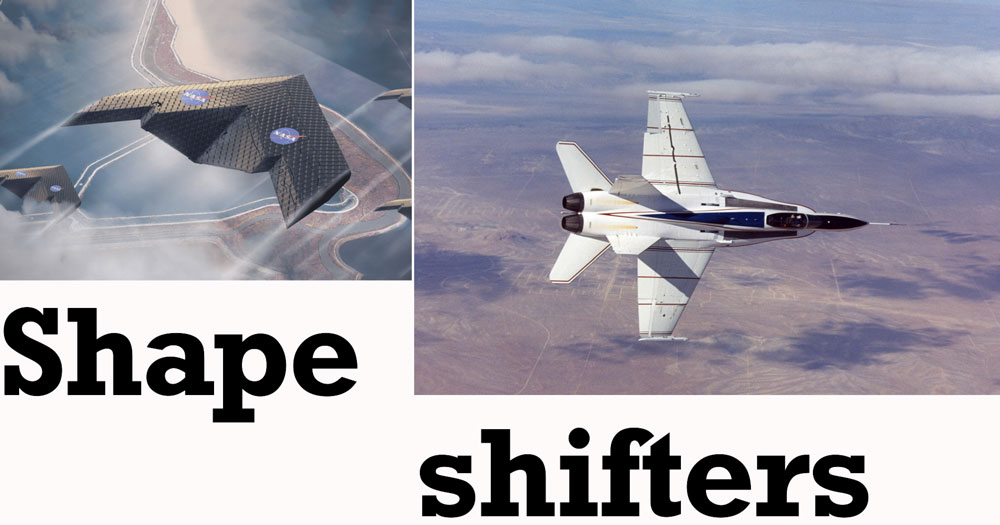 Left: NASA/MIT morphing wing. Right: NASA’s Active Aeroelastic Wing F/A-18 performs a 360º aileron roll during a research flight.
Left: NASA/MIT morphing wing. Right: NASA’s Active Aeroelastic Wing F/A-18 performs a 360º aileron roll during a research flight.
The traditional rigid structure of an aircraft has meant that its wings cannot operate at their full efficiency at different stages of flight. However, the development of new technology is now enabling engineers to create new morphing aircraft designs which can change shape in flight. BILL READ FRAeS reports.
Since the beginning of manned flight, the main aim of aircraft designers has been to create a largely rigid structure which can safety withstand the rigours of flight, including such factors as high speed, adverse weather and extreme temperatures. Aircraft designs are also as lightweight as possible to maximise speed, range and fuel efficiency.
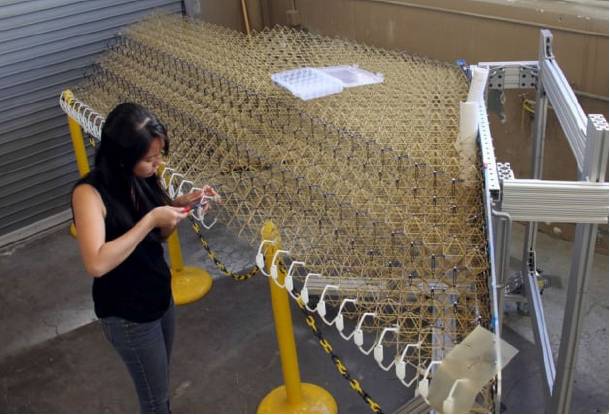 The NASA lattice block morphing wing under assembly for testing purposes, this initial wing was hand-assembled but future versions could be assembled by specialised miniature robots. Kenny Cheung, NASA Ames Research Center
The NASA lattice block morphing wing under assembly for testing purposes, this initial wing was hand-assembled but future versions could be assembled by specialised miniature robots. Kenny Cheung, NASA Ames Research Center
The shape of an aircraft’s wings will affect its performance. Wing shapes are often defined by their aspect ratio – the length of the wingspan divided by the mean of its chord (the distance between the leading and trailing edge). Different aspect ratios will affect the amount of light-induced drag that a wing will create. Wings with lower aspect ratios will have more induced drag than those with high aspect ratios. An increase in wing aspect ratio would result in an increase in both range and endurance. Aircraft with large wingspans have good range and fuel efficiency but are slower and less manoeuvrable. Aircraft with low aspect ratio wings are faster and more manoeuvrable but have poor aerodynamic efficiency.
Aircraft designers have therefore varied the shape of an aircraft and its wings depending on their intended use – for example, slow-flying gliders have long thin wings while fighter aircraft have short tapered wings for fast flight. The result is an aircraft shape which can fly close to its optimum in certain flight conditions but at sub-optimal performance for other conditions.
In addition, aircraft also have to be able to take off, land and manoeuvre and so the designs have incorporated movable control surfaces in the rudder and wings, as well as flaps or slats to change the geometry of the wings.
Changing wings
The concept of morphing wings is not a new idea. The original Wright brothers Flyer 1 in 1903 was operated using wires and pulleys controlled by the pilot which provided roll control by bending and twisting the wood-and-canvas wings.
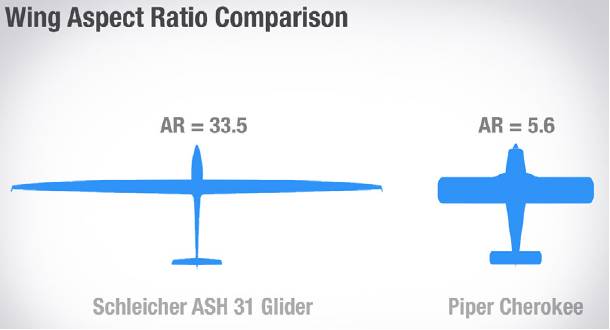 Wing aspect ratio comparison. Bold Method/Colin CutlerThe advantages offered by the application of morphing techniques have long attracted the interest of military aircraft designers. A number of military fighters have been fitted with variable geometry wings with the aim of maximising performance at both low and high speeds with high-speed cruising efficiencies and supersonic penetration speeds at low level. These include the General Dynamics F-111, Grumman F-14 Tomcat, Panavia Tornado, Sukhoi Su-22 and Su-24, Mikoyan Mig-23, Tupolev Tu-160 Blackjack, as well as the Rockwell B-1 Lancer bomber.
Wing aspect ratio comparison. Bold Method/Colin CutlerThe advantages offered by the application of morphing techniques have long attracted the interest of military aircraft designers. A number of military fighters have been fitted with variable geometry wings with the aim of maximising performance at both low and high speeds with high-speed cruising efficiencies and supersonic penetration speeds at low level. These include the General Dynamics F-111, Grumman F-14 Tomcat, Panavia Tornado, Sukhoi Su-22 and Su-24, Mikoyan Mig-23, Tupolev Tu-160 Blackjack, as well as the Rockwell B-1 Lancer bomber.
In the 1980s, Rockwell conducted the active flexible wing (AFW) programme which adapted conventional control surfaces to be used as aerodynamic tabs to control the aeroelastic twist of the wing, allowing the aircraft to operate beyond the dynamic pressure where conventional aileron reversal begins. AFW was followed by the Active Aeroelastic Wing (AAW) research programme funded by the US Air Force and NASA between 1996-2005 which used AFW technology on a modified F/A-18.
Recent years have also seen the development of aerial vehicles which are designed to change shape during different phases of flight. Many designs from the new generation of urban air mobility (UAM) ‘flying taxi’ platforms can morph from rotary-wing during take-off and landing to fixed-wing during flight.
Morphing structures – new materials
While recent years have seen a renewed interest in aircraft designs which can change shape using conventional technology – in particular eVTOL UAMs – engineers are also looking at designs which include wings that can twist and bend without the need for conventional aerofoils. Until recently, the development of such morphing aircraft was restricted by technological limitations which prevented the creation of structures that could change shape while still being lightweight and maintaining their structural integrity.
Morphing wings can change shape in a variety of ways: planform alteration (involving span, chord and sweep changes), out-of-plane transformation (twist, dihedral/gull and span-wise bending) and aerofoil adjustment (camber and thickness).
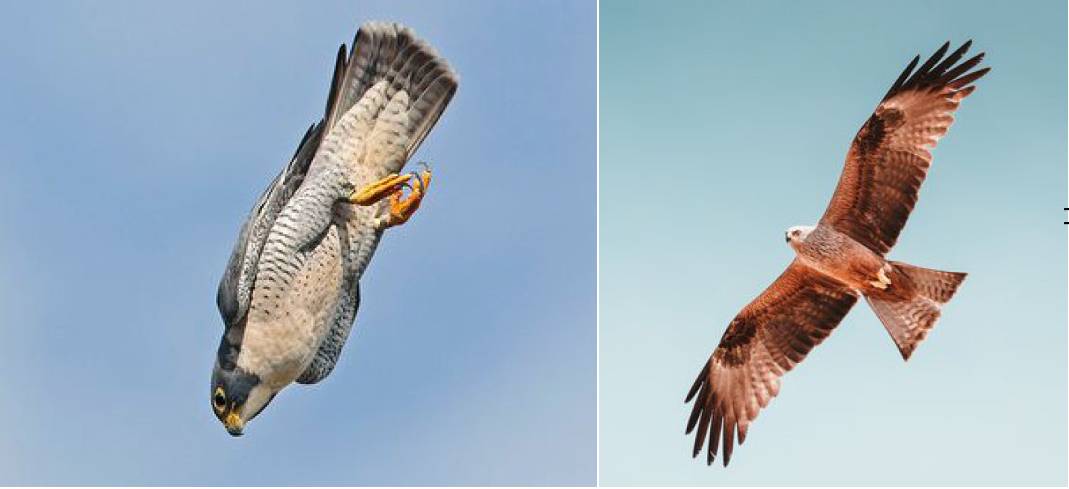 A peregrine falcon diving with wings closed/black kite soaring with wings outstretched. Martin Adams/Jim Zipp
A peregrine falcon diving with wings closed/black kite soaring with wings outstretched. Martin Adams/Jim Zipp
Looking at the first of these – increasing the wingspan increases the aspect ratio and wing area and decreases the span-wise lift distribution for the same lift. The reduced drag on the wing can enable increases in an aircraft’s range. However, there is a problem, as a longer span is more subject to wing root bending and will have to be strong and flexible enough to withstand the increased forces subjected to it. There is also the issue of scale. A large morphing wing will not have the same structural stiffness as a small morphing wing.
There have also been difficulties with attempts to twist and deform wings. Wings of high-performance aircraft are deliberately stiffer than those in slower aircraft, as too much flexibility can cause adverse aeroelastic twist which degrades the control effectiveness at high aerodynamic pressures. Designers of morphing versions of such aircraft would have to create a structure which it would not only be more difficult to bend but which must also be strong enough to withstand the additional loads and stresses of high-performance flight. As a result of this, apart from variable-sweep and swing-wing fast aircraft designs, most morphing applications have been restricted to lightly loaded, relatively low-speed designs.
3-2-1 actuate!
The current conventional approach to enable wing shape-changing is to fit mechanical actuators attached to internal mechanisms within the wing covered with flexible/sliding aerodynamic surfaces, together with load-transfer attachments between the skin and the skeleton. This requires a distributed array of actuators, mechanisms, and materials that slide relative to each other.
An additional challenge is that of structural integrity. The system must also be able to lock in place when the wing is under load to avoid the actuators having to maintain their position without the support of a structural element.
However, in many cases, using such a system of actuators adds so much weight to the structure that it cancels out any efficiency advantages produced by the smoother aerodynamic surfaces. The speed at which morphing occurs is also important, as rapid changes can significantly increase aircraft manoeuvrability. There is also the problem that an aircraft will need additional power to operate internal actuators, as well as the issue of what happens if the power fails or the actuators fail to operate and the wing is left in a sub-optimal position.
Another issue is the design of a flexible skin which can bend and stretch while morphing. While conventional hinged mechanisms are effective in controlling airflow, they are not efficient, as hinges and other junctions create surface discontinuities, resulting in unwanted fluid dynamic phenomena. The skin on a morphing structure must be soft enough to allow shape changes and also stiff enough to withstand aerodynamic loads and maintain its shape. Skins can either be made from a single flexible material or constructed using overlapping pieces imitating scales or feathers.
 NASA 21st Century Morphing Aircraft concept from 2001 showing how an aircraft could change shape during different phases of flight. NASA
NASA 21st Century Morphing Aircraft concept from 2001 showing how an aircraft could change shape during different phases of flight. NASA
Smart structures
However, the advancement of morphing wings has been facilitated by the recent development of new materials and mechanisms which can enable the creation of moving structures to a degree not previously possible. Engineers are developing smart materials which embed active elements into conventional structural materials. There are two different approaches to using these materials – one being to create structures which combine rigid and flexible elements and the other to combine the elements of both in a flexible lattice which can flex but then return to its original shape – similar to a sponge.
Smart structures can either use actuators to make a structure bend or incorporate actuators into the material to make a structure that bends. Typical smart structure actuators include: shape memory alloys (SMAs), piezoelectric and electrostrictive ceramics, magnetostrictive materials and electro- and magneto-rheological fluids and elastomers. When embedded with a network of sensor and control systems, the structural performance of the wing can be changed to meet different operational performance criteria, as well as to repair damage.
Smart structures are being applied to a wide range of potential applications to enhance aircraft performance. Four areas include: vibration/acoustic control, shape control, multi-functional smart structures and morphing aircraft.
Smart materials
In addition, there have been advances in smart materials which can change shape. One example is shape memory alloy which contracts when heated above a certain temperature while another is ‘piezoelectrics’ which can contract or extend when an electric field is applied to it. Using a combination of these materials can enable an entire wing to change shape.
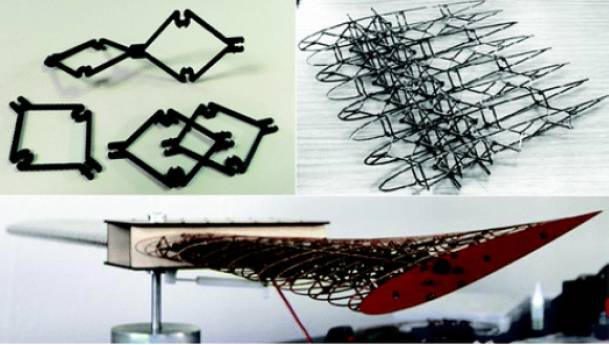 Lattice building block elements can be assembled into shape changing structures. Jenett et al Soft Robotics
Lattice building block elements can be assembled into shape changing structures. Jenett et al Soft Robotics
Another area of research has been into cellular solids comprising the interconnected honeycomb of beams or plates which form the edges and faces of cells and offer both high strength and stiffness per weight at very low mass density. These can be used to construct complex composite structures which can be assembled in different spacial geometries to exhibit a variety of load responses. The EU 3AS project looked at the development of ‘smart spars’ to enable the control of the bending and torsional stiffness of aircraft wings through changes in the internal aircraft structure.
Researchers from MIT are working on a project which makes the whole wing the mechanism so that its shape can be changed and twisted uniformly along its length by activating two small motors that apply a twisting pressure to each wing tip. Research is also being conducted into the construction of wings (and other structures) from ‘digital materials’ – tiny, lightweight structural pieces which can be assembled into an infinite variety of shapes using miniature robots that would crawl along or inside the structure as it took shape. Structures created using this method are said to have an exceptional combination of strength, low weight and flexibility. Unlike the construction of composite wings which requires specialised equipment for layering and hardening the material, new modular structures could be rapidly manufactured in mass quantities and assembled robotically.
Smart materials can also incorporate embedded sensors to provide built-in structural quality assessment capabilities. Typical smart structure sensors include: fibre optics and piezoelectric ceramics and polymers. Such structures could then sense external stimuli and respond with active control.
In 2017, a team at NASA’s Ames Research Center named MADCAT (Mission Adaptive Digital Composite Aerostructure Technologies) working in collaboration with students from the Massachusetts Institute of Technology (MIT), Cornell University, UC Santa Cruz, UC Berkeley, and UC Davis created an ultra-light wing that can actively change shape. The wing was constructed from advanced carbon fibre composite materials, assembled into a lattice and fitted with actuators to enable it to morph and twist.
In 2019, MIT announced that it had, together with NASA, built and tested an aeroplane wing, assembled from tiny subassemblies into a lightweight lattice framework and covered with a thin layer of similar polymer material. According to NASA, because the wing structure is composed mostly of empty space, it forms a mechanical ‘metamaterial’ which combines the structural stiffness of a rubber-like polymer and the extreme lightness and low density of an aerogel. The wing is able to automatically respond to changes in its aerodynamic loading conditions by shifting its shape using a selfadjusting, passive wing-reconfiguration process.
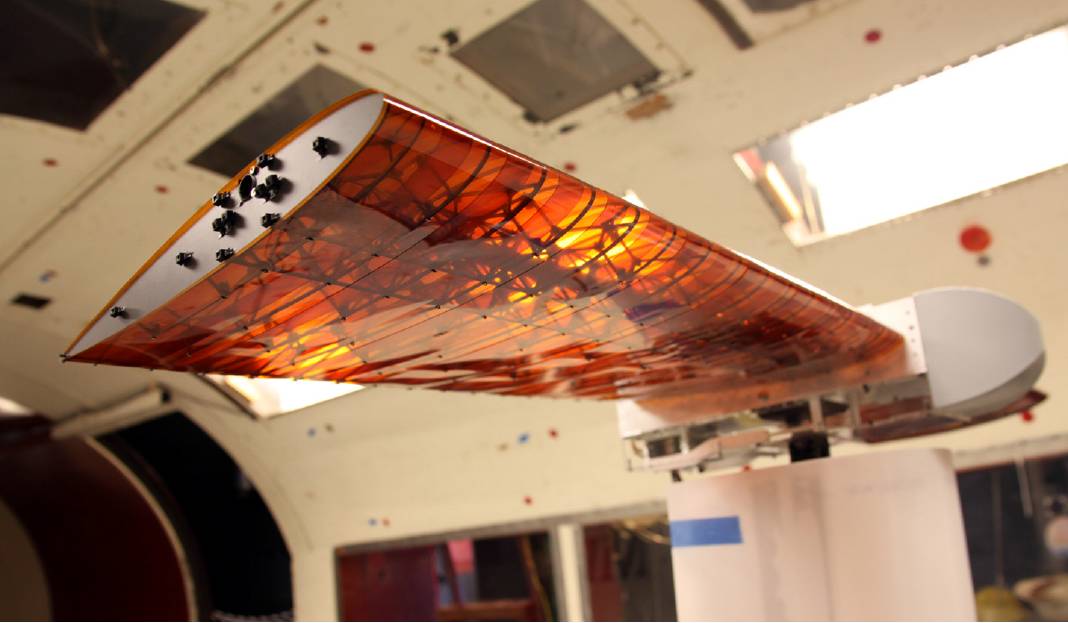 NASA Ames’ composite cellular material morphing wing can twist and move without the need for wing flaps or ailerons. Researchers at the University of Tokyo have created the DRAGON (Dual-Rotor embedded multilink robot with the Ability of multi-deGree of-freedom aerial transformatiON) snake-like drone which can twist and bend at any angle to pass through narrow spaces. NASA/Kenneth Cheung
NASA Ames’ composite cellular material morphing wing can twist and move without the need for wing flaps or ailerons. Researchers at the University of Tokyo have created the DRAGON (Dual-Rotor embedded multilink robot with the Ability of multi-deGree of-freedom aerial transformatiON) snake-like drone which can twist and bend at any angle to pass through narrow spaces. NASA/Kenneth Cheung
The UAV advantage
However, there is a limit to how far large commercial aircraft can go in imitating the behaviour of birds, as such avian manoeuvres as swooping and diving are not compatible with the comfort and safety of passengers. Commercial aircraft may also be too large for morphing wings to safely maintain rigidity. The same issues also apply to crewed military aircraft which, although they are small enough to maintain structural integrity and pilots can be protected using safety restraints and G-suits, can still not shift about the sky in the same way as a bird can.
 University of Tokyo/YouTube
University of Tokyo/YouTube
No such restrictions need apply to unpiloted aircraft which can be both small enough to maintain structural integrity and can make manoeuvres without regard to pilot safety. UAVs have also been used as the testing ground for morphing and smart structures.
Researchers have developed various expanding wing UAVs. A paper published in the RAeS’ The Aeronautical Journal in January 2021 looked at a Chinese proposal for a ‘smart morphing’ UAV which could extend range on military reconnaissance and surveillance missions. Fitted with self-sensing and adaptive control abilities, the UAV can change shape autonomously to different wing geometries, depending on flight tasks and flight environments. The control system of the UAV is based on particle swarm optimisation, an intelligent algorithm designed to imitate the foraging behaviour of birds. The morphing is achieved through the continuous deformation of the wing, changing camber, span and sweep angle using compliant runners driven by linear ultrasonic motors.
Morphing solutions are not limited to drones with conventional wings but also to hovering designs. Researchers have been investigating how shape-changing drones could be used to conduct surveys or reconnaissance missions which involve passing through confined spaces. These include quadcopters which can contract their rotor arms to fit through narrow gaps, drones which can assume different shapes and linked rotary wing drones which can fly snake-like in a straight line or wrap themselves around objects to lift them.
An extended version of this article can be found in the AEROSPACE Blog and App.
 Left: NASA/MIT morphing wing. Right: NASA’s Active Aeroelastic Wing F/A-18 performs a 360º aileron roll during a research flight.
Left: NASA/MIT morphing wing. Right: NASA’s Active Aeroelastic Wing F/A-18 performs a 360º aileron roll during a research flight. The NASA lattice block morphing wing under assembly for testing purposes, this initial wing was hand-assembled but future versions could be assembled by specialised miniature robots. Kenny Cheung, NASA Ames Research Center
The NASA lattice block morphing wing under assembly for testing purposes, this initial wing was hand-assembled but future versions could be assembled by specialised miniature robots. Kenny Cheung, NASA Ames Research Center




